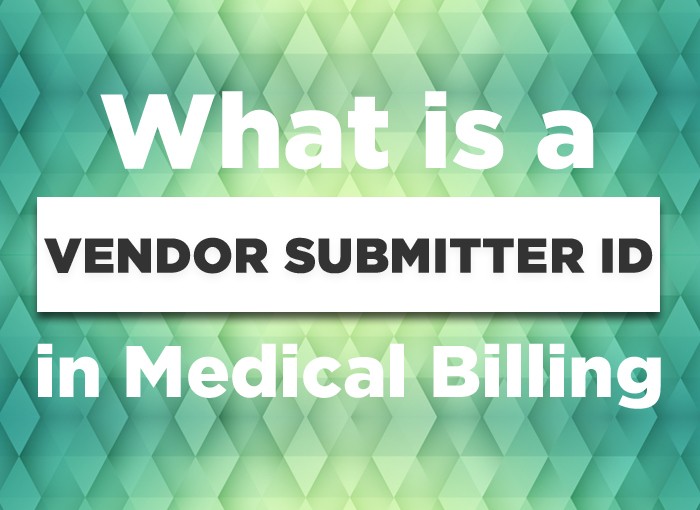What is a Vendor Submitter ID in Medical Billing
Understanding the term Vendor Submitter ID
To establish the Vendor Submitter ID definition, the terms that closely accompany it must first be defined; these are submitter, vendor, software vendor, and submitter ID.
- Submitter: Per CMS, a submitter is an entity that owns the Submitter ID linked to the submitted healthcare data. This is typically a provider, hospital, clinic, supplier, or a third party submitting on their behalf. Each submitter must be directly associated with a billing NPI.
CMS also clarifies that “often the terms submitter and trading partner are used interchangeably because a Trading Partner is defined as the entity engaged in the exchange or transmission of electronic transactions. Thus, the entity that is submitting electronic administrative transactions to [MAC name] is a Medicare FFS trading partner.”
- Vendor: CMS defines a vendor as “an entity that provides hardware, software, and/or ongoing technical support for covered entities. In EDI, a vendor can be classified as a software vendor, billing, network service vendor, or clearinghouse.”
- Software Vendor: An entity that makes such software available to billing services, clearinghouses, and providers/suppliers for the electronic transactions exchange with Medicare FFS is further qualified as a software vendor.
- Submitter ID: A submitter ID is an identification number that is used in the electronic submission of medical claims as the identification of electronic submitters for an efficient claim process. Each submitter ID will correspond with one or more NPIs.
Based on the above definitions, it may be said that the term Vendor Submitter ID is another term for Submitter ID. The word ‘vendor’ may simply indicate that the submitter is a vendor or a clearinghouse who is submitting claims on a provider’s behalf.
Submitting Claims using Submitter ID
As a healthcare provider, you can submit claims in two ways:
Directly to the Payer
- To submit claims directly, you need a Submitter ID from the payer.
- For example, if submitting a Medicare claim through a CMS contractor, request the Submitter ID from the contractor (an EDI vendor approved by CMS).
Through a Clearinghouse
- Using a clearinghouse eliminates the need for a Submitter ID request.
- This will send claims on your behalf to the payer using its Submitter ID.
A provider and a clearinghouse must both complete an EDI form to apply for a Submitter ID.
Additional Key Components of Submitter IDs
The Submitter ID system plays a crucial role in the healthcare revenue cycle. Here are important aspects to understand:
- Format and Structure: Submitter IDs typically follow a specific format determined by each payer. For Medicare, it’s usually an alphanumeric code between 5-8 characters. Commercial payers may have different formats, making it essential for billing staff to maintain accurate records of different Submitter IDs.
- Testing Requirements: Before submitting live claims with a new Submitter ID, payers typically require a testing period. During this phase, providers or clearinghouses must submit test claims to ensure their systems are properly configured and can handle the electronic interchange correctly.
Best Practices for Managing Submitter IDs
Healthcare organizations should follow these best practices:
- Documentation: Maintain a comprehensive log of all Submitter IDs, associated passwords, and which payers they correspond to. This documentation should be regularly updated and securely stored.
- Regular Monitoring: Implement a system to monitor claim submissions and track any rejections or errors associated with Submitter IDs. This helps identify and resolve issues quickly.
Common Challenges and Solutions
Healthcare providers often face these challenges with Submitter IDs:
- Multiple ID Management: Large practices dealing with numerous payers may need to manage multiple Submitter IDs. Using practice management software that can handle multiple IDs efficiently can help streamline this process.
- System Updates: When payers update their systems or requirements, Submitter IDs may need to be recertified or updated. Maintaining open communication with payers and staying informed about upcoming changes is essential.
Selecting Between Direct Submission and Clearinghouse
When deciding between direct submission and using a clearinghouse, consider these factors:
- Volume of Claims: Practices with high claim volumes might benefit more from clearinghouse services, as they can handle multiple payer requirements efficiently.
- Technical Capability: Direct submission requires more in-house technical expertise and resources to manage the EDI process.
- Cost Considerations: While clearinghouses charge fees, they may be more cost-effective when considering the time and resources needed for direct submission management.
Role of Submitter ID
In medical billing, the Submitter ID acts as a non-transferable electronic signature carrying the submitter’s information like name, number, etc. To prevent the misuse of the EDI it is requested not to share the Submitter ID and password with anyone.
Why Is a Vendor Submitter ID Important?
A Vendor Submitter ID is super important for medical billing because it helps in several ways:
- Ensures Accuracy: Links claims to the correct provider, reducing errors.
- Improves Efficiency: Speeds up the electronic claims process for faster payments.
- Enhances Security: Restricts claim submissions to authorized entities only.
How to Get a Submitter ID
If you’re a healthcare provider and need a Submitter ID, here’s how to get one in a few simple steps:
- Identify the Payer: Determine the insurance company you’ll submit claims to.
- Contact the Payer: Request forms and instructions from the payer or contractor.
- Complete the EDI Form: Fill out the form with your practice details, including your NPI.
- Submit the Form: Send it to the payer or contractor as directed.
- Receive Your ID: Once approved, you’ll get your unique Submitter ID for claim submissions.
This ID will help you submit claims smoothly and get paid on time!
Conclusion
Healthcare providers and their partners must understand and use the Vendor Submitter ID correctly. That means proper submissions of electronic medical claims, a well-oiled, error-free, and secure process, and ultimately, better reimbursements and operational flow. Navigating the complex world of medical billing will then become possible by practicing and keeping up.



